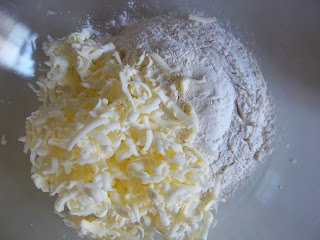This recipe puts me three-quarters of the way through the book! Who'd have thunk I'd still be ploughing through it!?
The fourth and final eel recipe from the book just in time for Good Friday, hopefully it will be better than the third which was a disaster…Eel pies or pasties are a food that has a very long history in Britain. Sometimes they were just simply unskinned eels, herbs, spices and water covered with a ‘coffin’ of pastry, probably eaten as a stew rather like water-souchy; the pastry simply serving as a vessel within which to cook the fish. The earliest mention of eel pie I have found comes from an article by A. Peripatetic in a 19th Century periodical called London Society:
East-Farleigh lies in the hundred of Maidston, and was given to the prior and monks of Christ-Church in Canterbury, by Ediva the Queen, mother of the two kings Eadred and Edmund in the year 941, and was…to find the convent with eel-pies.
Eels are associated the most with London and there is a great old proverb that I discovered is used in Shakespeare’s King Lear, which I can really relate to:
Lear: Oh me, my heart, my rising heart! but down.
Fool: Cry to it, nuncle, as the cockney did to the eels, when she put
Them i’the paste alive; she rapt ‘em o’the coxcombs with a stick,
And cry’d, Down, wantons, down!
In other words, she was so squeamish about killing the eels for her pie, she tried to bake them alive, making the whole situation worse and much more stressful than it would have been had she killed them. The first time I made eel I had to do away with them myself and it was pretty distressing (see here).King Lear and Fool
I’m quite glad to have come to the end of the eel recipes to be honest because I was starting to feel rather guilty about eating a fish whose numbers have been in sharp decline. Anyways, if you do come across an eel for sale you may as well purchase it and turn it into a little piece of history as I did:
The first thing you need to make is the pastry – an unusual one using grated butter and cream that is somewhere between a flaky pastry and a shortcrust.
Place a block of butter in the freezer until it is well-chilled, but not frozen. Meanwhile measure out 6 ounces of flour and mix in a good pinch of salt. Next grate the butter over your kitchen scales until you have 3 ounces and add this to the flour.
Add enough cream – use either single or soured – or water to form a good soft dough, stirring in your liquid of choice at first with a knife then bringing it together with your hands. I noticed that the flour required more cream than it would have needed if using water. Cover and chill in the fridge for at least an hour. A note to Americans: Soured cream in the USA is far too thick as an option, so go for something like half-and-half or heavy cream.
Peel and finely chop four shallots and soften them slowly in butter in a wide shallow pan. When cooked, tip them into a shallow pie dish or plate with a capacity of around 2 pints.
Now prepare the eels, you need 1 ½ pounds altogether (if your eels are alive, have a gander at this post and also this one, for the good it’ll do you). The best way to skin them I have found is to cut around the base of the neck, then hold down the head firmly with a dry cloth and pull the skin off in one long piece with a pair of pliers like a slender stocking. Trim the thin ends of the tails and add them to a pan along with the heads to 18 fluid ounces of chicken or fish stock, and simmer them together for around 20 minutes. In the meantime cut the eels into one inch pieces.
Coat the eel pieces in seasoned flour and fry them, in batches if necessary, browning them well. Add more butter if need be. Scatter the eel pieces over the shallots and deglaze the pan with the eel-flavoured stock, and reduce it by about a half, then add 2 tablespoons of medium dry sherry and 5 fluid ounces of double cream. Boil for 2 more minutes before adding ½ teaspoon of thyme and 3 tablespoons of chopped parsley. Season with salt, pepper and lemon juice. Add a further tablespoon of sherry if you fancy. Pour the sauce over the eels and allow the whole thing to cool.
Peel and slice two hardboiled eggs and scatter them over the eel, then roll out your pastry, gluing it to the rim of the dish with some more cream. Add a hole or a slit for the steam to escape and decorate with the trimmings - I went with a very complex eel motif of my own design. Glaze with cream and bake at 220⁰C (425⁰F) until the pastry has turned an appetising shade of brown – around 10 or 15 minutes, then turn down the heat to 180⁰ (350⁰F) for 20 minutes.
Grigson suggests serving the pie with peas or a chicory salad, though I just went with a mixed salad.
#337 Eel Pie. A very good recipe this one – especially if you are a newcomer to eel. The sauce was nice rich, and the eel tender. The good thing about eel is that it has a very simple anatomy so the bones are fairly easy to find and remove. The sauce was a little too thick and overpowered the delicately-flavoured eel a bit. It deserves a healthy 6.5/10.










No comments:
Post a Comment